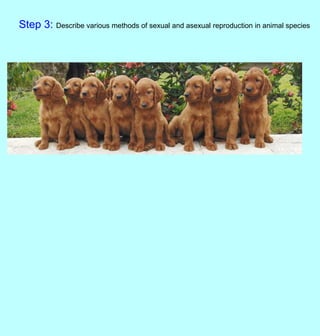
Sexual reproduction in animals teacher
- 1. Step 3: Describe various methods of sexual and asexual reproduction in animal species
- 2. Reproduction (or procreation) is the biological process by which new "offspring" individual organisms are produced from their "parents". Reproduction is a fundamental feature of all known life; each individual organism exists as the result of reproduction. The known methods of reproduction are broadly grouped into two main types: sexual and asexual
- 4. 1) Internal cross-fertilization - Most mammals (except for Australian montremes like the duckbill platypus)
- 5. As a reminder... What are our observations and inferences about this based on what we see and what we already know?
- 6. Sperm and egg cells are referred to as gametes The fusion of these gametes is referred to as fertilization Because each human gamete has 23 chromosomes, a zygote is formed with a total of 46 chromosomes How does it work?
- 7. The zygote divides through mitosis and eventually becomes an embryo All of these processes occur internally within the mother's womb The process is started by insemination through copulation
- 8. 2) External Cross-fertilization - most species of fish - most species of amphibians The details as to how this happen can vary...
- 9. How does it work? eggs are shed from the female into an aquatic environment Because of the flagella, sperm is adapted for swimming in an aquatic environment Sperm are shed onto eggs in order to fertilize
- 10. Specific Examples: - some species produce floating egg and sperm - some species attach the eggs to plants or other substrates
- 11. - some species (like salmon) deposit eggs into a hollow in a gravel based stream and males swim over to fertilize
- 12. What are the risks with external fertilization? - risk of predators and other external harms - open space can lead to lower probability of fertilization - demands millions to billions of sperm to compensate
- 13. - some species (cichlids) externally fertilize and then protect the zygote in their mouth until they are developed (mouth brooding)
- 14. 3) Hermaphroditic cross-fertilization A hermaphrodite is an organism that has both male and female reproductive organs - most snails - earthworms - some species of fish
- 15. How does it work? There are many different kinds of hermaphroditic species - Sequential Hermaphrodites: a type of species that is born as one sex and can change into the opposite sex The clown fish - All begin as male and the largest fish becomes the female
- 16. - Simultaneous Hermaphrodites: An adult species that contains both male and female reproductive organs at the same time. Self-fertilization usually does NOT occur Banana Slug - It is possible for banana slugs to mate as either male of female
- 17. 4) Hermaphroditic Self-fertilization Also called Autogamy. When two gametes are fuzed together from the same hermaphroditic individual - tape worms - most internal parasites
- 19. 1) Parthenogenesis - some small invertebrates (bees, scorpions, aphids, etc) - some vertebrates (fish, amphibians, reptiles)
- 20. How does it work? a form of asexual reproduction in which growth and development of embryos occur without fertilization Occurs naturally in some species but is artificially induced in other species This happens in two main ways
- 21. - apomictic parthenogenesis: This process occurs without meiosis Mature egg cells are produced by mitotic divisions, and these cells directly develop into embryos The offspring produced are full clones of their mother
- 22. - automictic parthenogenesis: This process involves meiosis the offspring differ from one another and from their mother. They are called half clones of their mother The other half of the alleles are developed through complex biological processes
- 23. Bonnethead A bonnethead, a type of small hammerhead shark, was found to have produced a pup, born live on 14 December 2001 at Henry Doorly Zoo in Nebraska, in a tank containing three female hammerheads, but no males. The pup was thought to have been conceived through parthenogenic means.
- 24. 2) Budding - Hydra, coral, sponges
- 25. How does it work? form of asexual reproduction in which a new organism develops from an outgrowth or bud due to cell division at one particular site The new organism remains attached as it grows, separating from the parent organism only when it is mature, leaving behind scar tissue.
- 26. the newly created organism is a clone and is genetically identical to the parent organism. Hydra reproducing asexually through the process of budding
- 27. Summary: Make a list of the advantages and disadvantages of all of the different types of sexual and asexual reproduction in animals